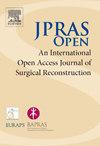以初叶为基础的三叶及四叶皮瓣重建鼻尖皮肤缺损。
IF 1.5
Q3 SURGERY
引用次数: 0
摘要
背景:尽管提出了绘制三叶和四叶皮瓣重建鼻皮肤缺损的各种原则,但这些原则的详细和可靠的应用仍然值得怀疑。方法:提出了一种新颖的三叶和四叶皮瓣修复鼻尖皮肤缺损的方法。该方法是基于使用四个总角为60°、70°、80°和90°的三叶皮瓣和两个角为90°和105°的四边形皮瓣对应的模板。将模板应用于手术野后,选择最合适的模板,以确保最后一瓣的供体缺损直接闭合并平行于松弛的皮肤张力线,而受体部位和其余供体缺损则被叶逐步覆盖。皮瓣的设计是在相应模板的指导下,按照明确的几何步骤进行设计,保证主叶的血管基部支撑其余叶。结果:模板引导皮瓣绘制准确、简便、省时。皮瓣的底部是最窄的,因此皮瓣的旋转弧度是最大的。这种方法在小直径超过2厘米的大尖端缺陷的情况下特别有用。结论:模板的使用可以可靠地设计出高效的基于初级叶的三叶和四叶皮瓣(PLBT和PLBQ皮瓣)。本文章由计算机程序翻译,如有差异,请以英文原文为准。
Primary-lobe-based trilobed and quadrilobed flaps for reconstruction of nasal tip skin defects
Background
Despite a variety of principles proposed for drawing trilobed and quadrilobed flaps for the reconstruction of nasal skin defects, the application of these principles in a detailed and reliable way remains questionable.
Methods
We present a novel method for drawing trilobed and quadrilobed flaps to cover nasal tip skin defects. The method is based on the use of templates corresponding to four trilobed flaps with overall angles of 60°, 70°, 80°, and 90°, and two quadrilobed flaps with angles of 90° and 105°. After applying the templates to the surgical field, the most appropriate one is selected to ensure that the donor defect of the last lobe is closed directly within and parallel to the relaxed skin tension lines, whereas the recipient site and the rest of the donor defects are covered by the lobes in a stepwise manner. Flap design is guided by its corresponding template according to clearly defined geometrical steps, ensuring that the vascular base of the primary lobe supports the rest of the lobes as well.
Results
Template-guided flap drawing is an accurate, easy-going, and time-saving process. The base of the flap is the narrowest possible, so the arc of rotation of the flap is the greatest possible. This approach is especially helpful in cases of large tip defects, where the smallest diameter exceeds 2 cm.
Conclusions
The use of templates results in the reliable design of highly effective primary-lobe-based trilobed and quadrilobed flaps (PLBT and PLBQ flaps).
求助全文
通过发布文献求助,成功后即可免费获取论文全文。
去求助
来源期刊

JPRAS Open
Medicine-Surgery
CiteScore
1.60
自引率
0.00%
发文量
89
审稿时长
22 weeks
期刊介绍:
JPRAS Open is an international, open access journal dedicated to publishing case reports, short communications, and full-length articles. JPRAS Open will provide the most current source of information and references in plastic, reconstructive & aesthetic surgery. The Journal is based on the continued need to improve surgical care by providing highlights in general reconstructive surgery; cleft lip, palate and craniofacial surgery; head and neck surgery; skin cancer; breast surgery; hand surgery; lower limb trauma; burns; and aesthetic surgery. The Journal will provide authors with fast publication times.
 求助内容:
求助内容: 应助结果提醒方式:
应助结果提醒方式:


